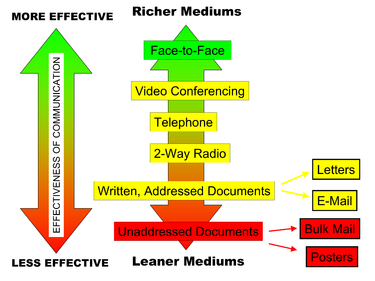Media Richness Theory
During my TTU Presentation in May, Dr. Eaton noted that I ought to check out media richness theory, since I might find some hints at these terms I’m trying to define, such as what I know I was incorrectly calling “humanness” (watch for upcoming posts on new terms). I’ve looked into this theory and see how it fits in with what I am doing.
Media richness theory, proposed by Daft and Lengel in 1984, essentially states that task performance increases when the task needs are matched to the medium’s richness. In other words, if I use the medium with a richness level most accurately suited to a given task to communicate that information about the task to an individual, the individual’s performance of that task will improve. Additionally, the theory suggests that individuals predictably favor the use of specific communication media to perform certain tasks. Specifically, that rich media are a more likely to be found appropriate for “equivocal” communication, which occurs more in complex tasks.
Daft and Lengel define the richness of media as the ability of information to change understanding within a time interval. The theory argues that the richness of media differs between media types, with face-to-face communication being richer then communicating via email for example. The richness of media is determined by four characteristics (Dennis and Valacich 1999):
Language Variety – The ability to convey natural language rather than just numeric information
Multiplicity of Cues – The number of ways in which information could be communicated
Personalization – The ability to personalize the message
Rapid Feedback – The ability to respond to the communicator in real (or near-real?) time
The more a medium possesses these characteristics, the richer it is.

To apply this theory directly to my research of the online video conversation in the classroom is somewhat difficult, since–as various scholars have pointed out (Schoon and van Velzen, Dennis, Valacich, et al.)–a main point where Media Richness Theory fails is the fact that the theory was developed in a time where there were no technologies like videoconference. These kinds of technology are, according to DeRosa, (2004) superrich.
So, the online video conversation in the online asynchronous classroom (containing no face-to-face element) would be superrich and, in the chart above, would reside below face-to-face and video conferencing, since the level of rapid feedback is just short of live at best

Time, I am fascinated with the concept of this, however, I believe, as we already discussed in part, that the graphic is incomplete. There’s a huge chance for you to propose a new depiction of Media Richness by including the participatory communication technologies that dominate the web today. One of them, obviously, online video and the application that you are focusing on. I am also wondering about the arrow on the left that indicates that the richer the medium, the more effective it is. Keeping the concept of rhetorical situation in mind, this might need to be qualified. I know you won’t make Media Richness theory the centerpiece of your work but I am sure you can add to the body of knowledge around it with your research.
Ah, one more comment… it would be interesting to describe all four characteristics in terms of the participatory, social media of today, especially, with the rhetorical invention that seems to occur as fast as new communication technologies hit the mainstream. Clearly, as you point out, the characteristics were developed when audience participation and easy content creation/publishing were not options for the individual. In addition ubiquitous connectivity was not even on the horizon (well maybe in the minds of some, but certainly not for the mainstream audience).
Okay, and one more… As discussed, here’s the link to a reply to your comment on post 4 in the Brave New World series at http://konjektures.com/2009/09/13/brave-new-world-4-pedagogical-considerations/#comment-169.
Comfort with the tools might be an interesting angle (certainly not to add to your current project :-), as would comfort with content creation vs. consumption.
Konnie, yes, I could certainly modify/update the graphic and place the genre(yes) of the online video conversation (OVC) on the scale (where I noted in the post). Of course, given this was created in 1984, there are many other communication forms and genre that could be added as well. The truth is that this is not the main theory I am going to use in my research. Rather, it is a background and foundational for other media theories that I am going to apply. The next in a series of three is Media Synchronicity, which I just posted on this morning. So, while this is not a theory I had intended to really flesh out at this point, your point does tempt me to update the chart and the theory to add to the effort of establishing and clarifying my own media theory that is exemplified by the OVC.
I think your point about the effectiveness arrow needing to be qualified is very valid. They do put forth a specific rhetorical setting and purpose, the theory seems to be put forth as far more global in its application. In this way, one must really question the goal, that is one should question how is the effectiveness qualified… and quantified for that matter?
Actually, the four characteristics they mention (and you reference) will definitely need to be applied to the communication method and genre that is the focus of my study. While I am not so sure I feel prepared to do that sufficiently at this juncture, the basic application to the OVC is:
Language Variety – It is highly natural, since participant communicate naturally, as they would in a face to face conversation. While any form of direct social anxiety is removed (being the person is generally alone and not in the same room as the co-participant), there is the potential for a different sort of anxiety that can occur in front of the camera.
Multiplicity of Cues – The OVC ranks extremely high here in that it offers both visual and audio communication: facial expression, hand gestures, eye movement, voice intonation, volume and pitch change, etc.
Personalization – One can certainly personalize the message, addressing it to an individual, a group, or the general public (which could also be considered as “to no one”).
Rapid Feedback – While one cannot respond in real time, conversations occurring with the OVC can actually be very close to real time, with a brief lag between exchanges. So, it is quite rapid.
Konnie, in regard to your last comment (comfort with the tools), there are a few great angles there. One aspect I mentioned above, that is the comfort one has in front of the camera. This is a common situation that most people experience but get past through use.
Of course, before that point in time, one must be comfortable with the tool(s). Since I require my students to use web-cams in my online class, I can see their comfort levels improve as the semester advances (smoother speech patterns, less fidgety, move away from printed scripts, etc.). They all just seem to be conversing more naturally toward the end of the semester.
The final thought I’d add to this is the comfort one has with making the video. By this, I mean the ease with which one can do it, based on their set up. Last semester, I had a video camera hooked up to my computer that I could turn on at any time and just record. It was just as easy as writing an email. Now, with virtually every laptop coming equipped with a built-in Web cam, it is even easier. There are so many video tools, both online site and desktop apps, that it is no longer a complex, difficult, time-consuming process to create a video.
This is a major point when it comes to people actually doing it. I’d venture to say that most people do not realize how easy (and inexpensive) it is to create conversational videos in this way. Once that knowledge is more widespread, the technology will likely become more ubiquitous as well. Truly, I see so much value in this form of communication, I’d love to see it become more of a common communication medium.